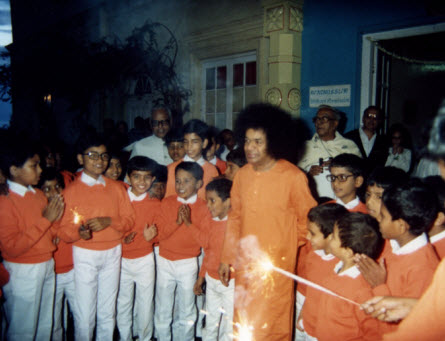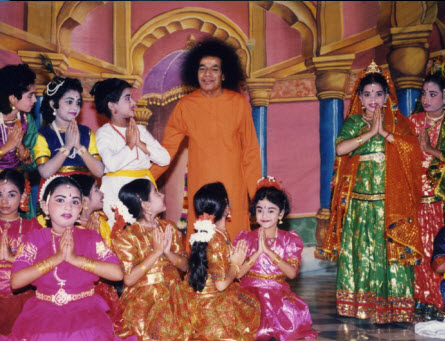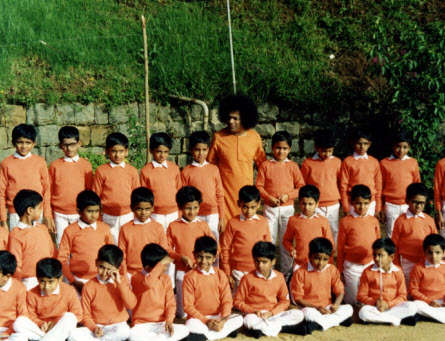GROUP ACTIVITIES
“Education must instill the fundamental human values; it must broaden the vision to include the entire world and all mankind. When earning money is held as the goal, the system fosters falsehood and injustice; it restricts the vision to family and community, and brings in its train, anxiety, sorrow and hatred. Education must equip man to live happily, without making others unhappy, to evaluate things, pleasure and possessions correctly and without prejudice, and to fix one's attention ever on the highest and the most precious achievement of all, the Atmic victory. The spiritual stream must flow in the heart as the source and spring of all endeavour.”
(Divine Discourse, 5 February 1981, Sathya Sai Speaks Vol. 15, Ch. 1)
-
-
Crowns We Wear - Groups 2,3,4
Values - Empathy, Sensitivity +Everyone sits in a circle. Each one has a paper crown on the head with directions for others to follow. No one is allowed to see their own crown. The crown directions could be like:
ALWAYS LISTEN TO ME
SAY YES TO EVERYTHING I SAY
SAY NO TO ALL MY SUGGESTIONS
DON’T LOOK AT ME
JUST KEEP SMILING AT ME WHEN I SPEAK
ASK ME TO BE QUIET WHEN I SPEAK
Give the group a simple topic to discuss and ask the children to follow the crowned directions whilst interacting with the one who is speaking at that moment.
YOU CAN GIVE TOPICS LIKE: (topic will depend on the Bal Vikas age group)
Is it always good to tell the absolute truth?
Who are the ones that need help?
What is a good character?
How do we see God in everything?
Let the group discuss till it becomes obvious that they are following the crowned directions on every speaker’s head. Let it last for may be for 8 to 10 minutes depending on the class size.
Analysis:
1. Ask each one to guess what they think is written on their crown. Once everyone has had a turn let them remove their crowns and read them.
2. Question how each one felt about others reacting to them when they were talking.
3. Bring out the concepts of Respect, listening kindly and attentively, being non-judgmental.
4. Talk to the children how each of us is God. Should we then feel anger, hatred, and inferior to others, superior to others, disrespectful or ridicule others? Will God do all that? If we are God we need to act like God!! Follow Baba’s footsteps in life. Be like the rose which speaks silently in the language of fragrance.
-
Effective Communication - Groups 1,2,3,4
Values - Communication, See God In Others +Game:
Divide the children in two groups. Make the groups sit in straight lines facing each other. Draw a medium sized circle between the two groups. You will be placing a small piece of paper in this circle only when the game begins.
Eg.
Group XX Group AA
XX AA
XX AA
XX O AA
XX AA
XX AA
Steps to play:
• Ask each team to choose 2 players.
• All other players have to be perfectly quiet during the game and watch carefully.
• Each team will blindfold one chosen player and the other becomes his partner and guide.
• The guide cannot touch the blindfolded person, but has to give only verbal directions to guide him towards the center and pick up the paper from the circle.
• Make the blindfolded player stand far away from the circle you’ve drawn.
• Place a folded paper with a value or a value quote written on it, in the circle. (egs. Be Good, See Good, Do Good that is the way to God or the ABC of life is Always Be Careful)
• Each guide from the 2 teams will walk next to their blindfolded team mate and verbally direct him to the value paper in the circle. They can give directions like, “turn slight to the left, bend towards the right, and stretch your left hand forward, touch the floor, and so on…” to lead them to the value.
• You have to tell the teams that the one who picks up the value from the circle first will win. Let the winners read the value to the rest of the class.
• The teacher makes no comments about the players’ behavior during the game, unless you observe the guide frustrating the blindfolded player. Request the other children to remain silent.
Play the game till all the children get a turn to be either the blindfolded player or the guide.
Analysis:
Ask everyone questions.
1. You can ask the blindfolded persons how they felt about their guide. (some will tell you that they felt the guide getting angry and frustrated and made them feel anxious… ) You will analyze it further and lead them to the value of patience and tolerance with further questioning.
2. Ask the guides how they felt whilst giving directions and what did they do when the blindfolded person did not follow them correctly.
3. Observe if the children who played guides, put more emphasis on being first and winning the game or being caring and careful with the blindfolded person even when it cost them the game. Ask specific questions on the behavior you observe.
4. Question to make the children aware that even in stressful situations like competition, which was introduced in this game, PATIENCE IS ALWAYS REWARDED. Hurry is Time Wasted as as Swami says, “Time waste is life waste.”
5. Question and bring out the value of LISTENING PATIENTLY WHEN SOMEONE IS TALKING TO YOU.(THE BLINDFOLDED PERSON HAS TO LISTEN TO ONLY THE GUIDE AND NOT THE OTHERS OR FOLLOW WHAT THE OTHERS THINK IS RIGHT)
6. Finally, ask who the blindfolded person in life is and who is the guide?
Extract this answer from the children- We are the blindfolded and anyone who leads us to God is our Guide. God Himself is our guide and He comes in the form of parents, family, teachers, friends and sometimes even strangers to show us the way to goodness and Godliness.
-
Aim For Values - Groups 1,2
Values - Good, Bad +Game:
Make nine pins from cardboard and write (love, hate, sharing, caring, meanness, jealousy) or draw and illustrate good or bad habits on them for younger children (E.g.: spitting on roads or littering, cleaning litter, helping, hitting)
Each child gets a turn to hit the 9 pins arranged in a particular bowling order with a soft ball. They have to aim for values.
If they hit a value pin, they can continue to play till they hit a bad habit. If they do not get a value pin then they forgo their turn till the next round.
After each child has had a turn, you can begin the second round. Play a few rounds as the children will have fun.
Now reverse instructions.
Ask the children to hit the bad habits and try to make them fall. If they hit good habits and make them topple then they are out of the game.
ANALYSIS:
1. Why did they think of a particular behavior was a value and aim for it?
2. Why did they think a particular behavior as bad?
BRING OUT THE SIGNIFICANCE:
1. In the first part of the game: This world is full of good and bad things. Aim only for good. If you aim for bad you lose a vital part of your character.
2. In the reversed version: Identify what is bad in the world and in ourselves and get rid of it.
-
Run For Values - Groups 1,2
Values - Good, Bad +Game:
Divide the class in pairs. One child from every pair will form the inner circle. The others form the outer circle.
Inner circle children will sit and outer circle children will stand behind their partner, ready to run around the sitting inner circle.
Teacher has to random keep circulating slips of paper to the inner circle children. Each paper will have either a good habit or bad behavior on it.
When the teacher claps hands or plays any musical instrument, the outer circle children have to run around the sitting circle.
When the clapping or music stops they have to run and stand behind their partner.
Partner will open a slip of paper and read it. If it is good then the child gets to run again; if it is a bad habit, the child sits facing the inner circle partner. Let them play for some time and then switch circles. Those who were running now sit and the sitting circle children get to run. Their partners remain the same.
Analysis:
1. Why do you think some of you got to run again? (discuss good behavior is rewarding)
2. Why do you think some of these behaviors are bad? What do they do to self and others? (Ask one question at a time and keep building questions based on children’s’ responses)
-
Magical Chant - Groups 1,2
Values - Namasmarana +Game:
It is similar to a tag game. All the children can run. Two from the class are selected; one to tag others called “BAD DEEDS” and the other to free the ones tagged called “GOOD DEEDS.” Bad Deeds will hold a small black flag and Good Deeds will hold a golden flag.
Everyone runs and Bad Deed tries to tag them. When he tags a child then that child has to stop running and stand still. The good deeds child has to rescue the tagged child by touching him and saying Sai Ram. The other child replies Sai Ram and is free to run again. If he forgets to reply Sai Ram, he cannot run till he remembers to do so.
Children can take turns to run and to be “good deeds” and “bad deeds”.
Analysis:
1. Why were those touched by Bad Deeds unable to move?
2. How did Good Deeds help them move?
Bring Out:
The power of namasmaranam in all our daily life.
-
PUT-APART-I - Groups 1,2,3,4
Values - Namasmarana +Game:
Give an age appropriate topic to each child and let them speak on it for 2 minutes. The RULE is they cannot use the pronoun, “I”. If they do they have to stop and sit down. The other children who are listening have to be alert to point out if the pronoun “I” is used.
Topic egs: (Try to think of topics where there will be self-involvement and doing something to help others. That is where our egos ride high!)
· Once you saw an old, wrinkled lady crying on the road as she couldn’t cross it…..
· You saw a baby bird falling from its nest….
· A homeless man asks you for food and help…..
· Your friend has failing grades in math and asks for your help…..
Analysis:
1. Why did we try not to use the pronoun “I”?
2. What is this “I”?
3. What happens to us when we use too much of “I” in our lives?
(Bring out the role of ego and self-involvement in our actions and thoughts and even social behavior. Talk about doing good even when there is no one to notice and acknowledge it. Explain finally why Swami says, “Put Apart The I” for Puttaparthi)
-
Alien Communication - Groups 2,3,4
Values - Empathy, Sensitivity +Game:
Select some children to act as aliens. They are now on Planet Earth and they need some essentials but do not know the language.
Give each of the aliens a paper with one picture like car, sandwich, mosquito repellent, house, pizza…. drawn on it.
Each alien has to act out the word depicted on his paper during his turn and the others have to guess what he wants in only 3 guesses.
Since aliens do not know our language, other children (humans)are given a bunch of random pictures with the actual ones mixed in them. They can choose the answer from these and show the selected picture to the alien for each guess.
If the humans guess the word correctly, the alien joins the Earth group, but if the word cannot be guessed the alien sits far away from the Earth group.
After each alien gets a turn to act, the teacher analyses the game.
Analysis:
The teacher has to observe everyone’s behavior during the game, so that you can question the children about why they reacted to the situation as they did.
1. Ask the aliens whose problem was solved about how they felt (you can ask them if the others made him feel comfortable whilst communicating)
2. Ask the aliens whose problems remained unsolved, about their feelings towards humans and self.
3. Question the humans about their feelings when the alien was trying to communicate to them. How did they feel when they got the right answer and also when they got a wrong one?
(Bring out the values of responsibility towards others who are in need, helping, patience in understanding and communication, especially with those who don’t speak the same language as ours. This is very prominently seen in USA as there are people from different nations speaking different languages, or in India where each state has its own language, so relate them to real life situations.)
-
Cross The River Of Life - Groups 1,2
Values - Unity of thought word and deed +Game: Draw a line dividing the room into two. One side of the line is the river and the other side is the land. One person becomes the coast guard and stands near the line in the river. All the kids, except the coast guard, will start by being in the river of life and have a paper pinned or stuck on them with either values or bad action written on it. (egs. Loves others, talks softly, helpful, peaceful, mean, tells lies, hurtful, beats animals, jealous, angry). The game begins with the kids asking the guard’s permission to cross the river to reach land. The guard has to say, “Not unless you have something good on you.” All the values will cross the river and reach the other side of the line which is land. The others have to try to cross the river and if the guard catches them they are out of the game. If any child with bad behavior written on the paper manages to cross the river and reach land, then all the good value kids on land will try to catch him and send him back to the river. Let the children play and enjoy for a while. Then the teacher analyzes: (Ask children subtle probing questions that will lead to these answers, instead of the teacher directly telling without children’s participation) 1. One side of the river is the world. Our life is entwined with our desires, emotions, feelings, thoughts, habits, attitude towards self and others. It has the good mixed with the bad. 2. The other side we cross to is towards God, which is the Goal of our Life and human birth. 3. The coast guard is our conscience, which allows good to enter and take us closer to God. It tries to catch and put away the bad to save us from doing wrong in life. But sometimes our conscience is not very vigilant. How do we keep it vigilant? Talk about contemplation on God and following Swami as role model. 4. Why did the good send away the bad? Talk about Swami emphasizing the significance of always being in good company. ABC of life is always be careful, says Swami. Talk how….. by keeping a unity between our thoughts, words and deeds. Questions you may ask: 1. What are the two sides of this river? Why does one side have good and bad and the other only good? 2. Who is the coast guard? 3. Why do you think the guard did not succeed in stopping all the bad from crossing? 4. Why did the good chase away the bad who somehow managed to cross the river and reach land? 5. How do we make this coast guard more alert? -
Respect for The Environment +
Parents are requested to read along with their children the attached Discourse of Swami. In this Discourse, Swami empasizes the need to show Respect to The Environment. The Discourse is from the Book, “Summer Showers in Brindavan 2000”, Discourse # 2 delivered on 15th May 2000. You can download the Discourse here:

-
Building a Story - "Can a Turtle Fly?" +
Spiritual Principle
With unity and love you can achieve the impossible.
Value & Sub-Values
The main value is Love and sub-values are unity, persistence, listening, following, etc.
Directions to the teacher
In this activity, the teacher gives only the first part of the story. The students work in groups without any supervision from the teacher and develop the remaining part of the story. The students can develop the story the way they want but there should be a moral in their part. At the end they get to present their story through skit, dance, song or storytelling. After all the kids have presented, the teacher gives the second part of the original story.
Part I - Story Briefing
Once there lived a turtle who badly wanted to fly. He goes and asks his close friends whether they can help him fly. The friends make fun of the turtle and ask him to try something else. The turtle does not give up. He asks yet another set of friends. They also tell the same thing. Finally the turtle meets two birds who agree to help the turtle fly.
Part II - Group Activity
Students work in groups for 15-20 minutes. Then they get to present their stories through song, dance and skit etc. At the end they give a moral from their part of the story.
Part III - Deriving the Principles
The birds agree to help the turtle fly. The birds instruct the turtle 1) to get a stick, 2) hold it with his mouth, and 3) not to open his mouth at any cost. The birds hold the ends of the stick with turtle holding the stick with his mouth in the middle. The birds take off and so does the turtle. But within a minute or two, the turtle falls plop on the ground. The birds take off. The turtle luckily falls in a pond and is saved. As the turtle is laying in the pond sad, another friend turtle approaches him find out what had happened. The turtle says "We started flying but soon other birds start to notice us. I opened my mouth to answer and I fell"
Moral of the original story
Persistence is good but you must also listen to others.
-



